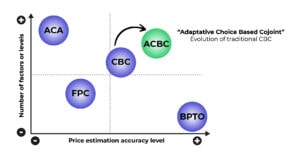Buyers don’t make decisions based solely on a single attribute like brand or price. Instead of making a decision, they examine products with all their possible combinations. Conjoint analysis is a multivariate analysis technique that replicates these complex consumer decisions, and these results aid in the optimal design of the commercial offer.
What Conjoint analysis accomplishes is determining the utility and importance that the customer assigns to each element of the offer when deciding to purchase it. This analysis allows for adjusting the offer, in terms of price and features, to the optimal level demanded by the market while considering the competitive environment in which the products operate.
This analysis is designed to identify the key elements or factors in the purchasing decision and the different values they can take in the market.
What is the objective of a Conjoint study?
Some of the objectives commonly covered by market research with Conjoint analysis include:
- Determining the relative importance of product choice factors
- Determining the price elasticity of the tested brands
- Quantifying the preference (utility) provided by each of the differentiating levels of factors (brands, price, service, etc.)
- Determining the level of demand provided by each of the analyzed products
- Determining demand transfers based on price variations that can occur. Identifying price differentials between offers.
- Identifying the combination of levels of different factors that provide higher demand
- Obtaining different typologies of individuals based on perceived utilities for each factor.
Different types of Conjoint analysis
Over the years, the process of collecting and processing information has evolved, bringing the interviewee’s experience closer to the reality that consumers face when making a purchasing decision.
- Full Profile Conjoint: Traditional Conjoint analysis based on card sorting (ranking). A series of cards representing different products are shown, and the interviewee ranks them from most to least preferred.
- BPTO – Brand Price Trade Off: Traditional Conjoint analysis with only 2 factors: brand (product) and price. For consumer goods, information collection is recommended through simulating a real supermarket aisle. This way, we ensure that the interviewees’ responses are as close as possible to what they would be in a retail setting.
- Adaptive Conjoint: This analysis is performed by adapting questions to the interviewees’ preference responses, so they evaluate each feature individually instead of responding jointly (as in cards).
- Choice-Based: Card-based Conjoint, like traditional FPC, but instead of ranking, the interviewee selects a single card from those shown—the one they would buy. This represents the purchasing reality where the final decision is based on «buy vs. not buy,» rather than ranking.
ACBC (Adaptive Choice-Based Conjoint) is a new Conjoint analysis technique that allows for a better estimation of price and the inclusion of more factors.
This model takes a significant step in handling the price variable, treating it as a continuous variable and establishing conditions so that products with higher features are always presented at higher prices than simpler products.
As we can see, there are different models that can help us determine the optimal price to maximize profits. At Hamilton Global, we specialize in selecting the right Conjoint model to achieve your goals. Contact us.



